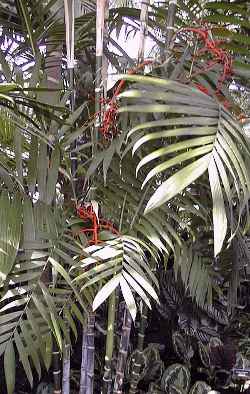Tepejilote Palm, Pacaya Palm
Scientific Name: Chamaedorea tepejilote H. Wendl.
Synonym: Chamaedorea alternans, Chamaedorea anomospadix, Chamaedorea casperiana, Chamaedorea columbica, Chamaedorea exorrhiza, Chamaedorea sphaerocarpa, Chamaedorea wendlandiana, Edanthe tepejilote, Edanthe veraepacis, Nunnezharia alternans, Nunnezharia casperiana, Nunnezharia tepejilote, Nunnezharia wendlandiana, Stephanostachys casperiana, Stephanostachys tepejilote, Stephanostachys wendlandiana
Family: Arecaceae
Sunset®: 16,17,22-25
USDA: 10-12
Frost Tolerance: 30°F (-1°C)
Sun Exposure: Shade to part shade, burn easily in direct sun light
Origin: Southern Mexico to Colombia
Growth Habits: Solitary, or occasionally clumping, thin palmtree, 8 to 20 feet tall (2.4-6 m); stem 0.8 to 4 inches in diameter (2-10 cm), and swollen nodes; 3 to 7 pinnate leaves, up to 5 feet long (1.5 m), 40 inches wide (1 m), with 12 to 50 velvety leaflets
Watering Needs: Regular water, keep the soil moist, needs good drainage
Propagation: Seeds, offsets
One of the taller Chamaedoreas, cultivated as a crop for its male inflorescences (pacaya). Pacaya is a popular and important vegetable, eaten raw or cooked, and sold in the markets. It is harvested before the inflorescence opens, at which stage it looks like an ear of corn. It is mostly harvested from plants of C. tepejilote, which has been cultivated for centuries, especially in Guatemala.
Fruiting Habits:
Globose, bluish black fruit, black when ripe, up to 0.32 to 0.5 inch in diameter (0.8-1.2 cm), with persistent petals
Propagation:
Some cultivars are clustering. It is difficult to know when you get them from a nursery, since nurseries put generally several plants in the same pot.
Desert-Tropicals is dedicated to provide gardening advice, gardening ideas, and information about flower of all kind for landscape and collections.We try to check carefully the identification of the plants on the illustrations as well as the other information from the page, but occasionally errors do occur. if you notice anything that needs to be changed please contact us.Thanks.
© 1998-2020 Philippe Faucon, All Rights Reserved.
